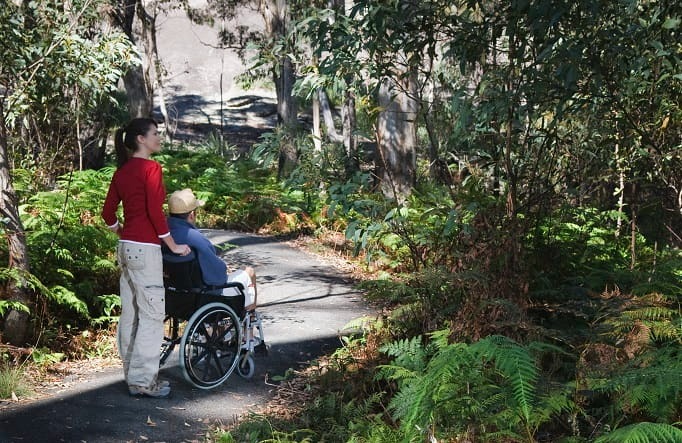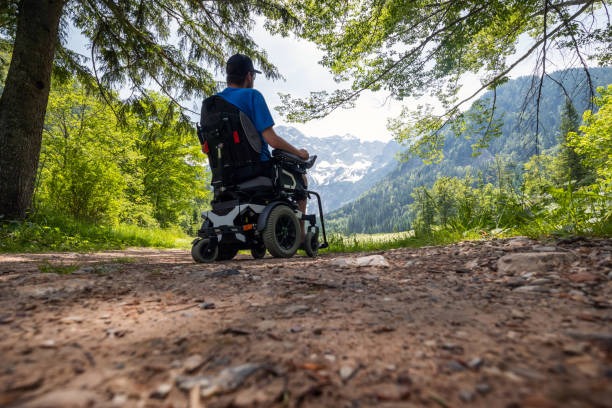
The Miles Without Stiles project extends access to the hills and lakes for individuals with restricted mobility. Our writer assists his friend in experiencing an invigorating route around Windermere.
Being the largest national park in England and a source of inspiration for figures like Wordsworth and Swift (Taylor, not Jonathan), the Lake District requires no introduction. However, my friend Anthony, who hasn’t graced a postcard or gained recognition from UNESCO, likely does.
Anthony and I have been friends since our university days. During the break between our second and third years, Anthony found himself tasked with the challenging job of promoting the drama society’s production at the upcoming Edinburgh Fringe. Upon noticing Anthony’s plea for help posted on the noticeboard in the campus launderette, I somewhat recklessly volunteered to assist him for a fortnight. Although selling a feminist adaptation of “The Wind in the Willows” proved to be a challenging endeavor, the experience yielded the substantial reward of cementing a strong friendship that persists to this day.
Due to a combination of his cerebral palsy and his involvement with a charity named Able Child Africa, Ant hasn’t explored the UK as much as he desires. When I suggested a winter excursion to the Lake District to climb a renowned peak, especially after discovering a recently developed set of accessible trails in the region, it only took him a few hours to warm up to the idea. Initially hesitant, he had raised objections citing the fear of missing an episode of Bake Off.
After a challenging afternoon on the M6, we reached Cumbria just as Storm Debi hit. Consequently, the initial phase of our getaway was spent appreciating the indoors, specifically the inviting ambiance of our hotel—a country house once owned by Beatrix Potter—on the eastern bank of Windermere. Lindeth Howe, akin to a charming great-aunt in hotel form, also stood out for its admirable accessibility, meaning I never had to provide Anthony with a piggy-back during our stay. The evening’s highlight unfolded with a brief blackout during dinner, sparking ghost stories, with the most intriguing one involving a ghost with amnesia.
Upon waking the next morning, it took me a moment to recall why I was lying within a meter of a geography graduate. Anthony was already awake and in a mischievous mood. “Coffee,” he declared. “Love one,” I replied. “That wasn’t a question,” he quipped. Oh, the benevolent types, right?
It didn’t take me much time after opening the curtains to confirm that the wind was still quite strong. Despite the inclement weather, we succeeded in creating an engaging morning, primarily by visiting a nearby Arts & Crafts house named Blackwell. There, we marveled at the craftsmanship and pondered whether William Morris’s golden rule—that people should have nothing in their houses that they do not know to be useful or believe to be beautiful—was an ominous sign for both of us.
Around this time, Storm Debi decided to redirect her downpour from drenching the Lakes to deluging Merseyside. Seizing the opportunity, we quickly jumped into the car, raced to Windermere, swiftly bundled up, and embarked on a journey to the summit of a nearby hill.
The trail leading to Orrest Head is one of over 50 routes constituting the Miles Without Stiles initiative. Each route has been selected with wheelchairs and pushchairs in mind, with some routes being adapted accordingly. The collection provides a diverse range of options, such as a circuit around Buttermere, a stretch along Derwentwater, or an ascent of Latrigg Fell. Furthermore, if you have the determination but lack the wheels, several sites in the region offer the rental of robust mobility scooters, known as Trampers, for as little as five pounds.

The initial phase of the ascent towards Orrest Head meandered through an area of ancient woodland, densely populated with oak, ash, beech, and sycamore trees. The trail unintentionally turned into a carpet of fallen leaves, and the drystone walls bordering it were adorned with vibrant green moss. Despite attributing some initial wheelspins to jetlag (having traveled from London), Ant found the ascent quite manageable in his new mode of transportation—a generously lent SD Motion Trike from Steering Developments. He kept mentioning terms like traction and muffler, displaying no remorse as he effortlessly passed a mobility scooter on the straight path.
Not that we were in any rush. If anything, we were deliberately slowing our pace, immersing ourselves fully: the distant melodic chimes of a church bell, the potential sighting of a kestrel or buzzard. Our minds, liberated from their usual routines, now had the freedom to wander. Anthony took advantage of this newfound expansiveness by contemplating aloud which trees grow the tallest and the purpose of lichen. Conversely, I took advantage by pondering how challenging it might be to secure a ticket for the Girls Aloud reunion tour. Despite our contrasting thoughts, our minds shared a significant commonality—they felt more liberated and unburdened for the journey, the climb, the leisurely stroll. The simplicity of purpose, the natural surroundings, and the invigorating air all converged to make the experience enjoyable.
However, nothing compared to the spectacular view at the summit, which was even more breathtaking for being revealed all at once, having not been glimpsed along the way. It was a genuine revelation, exceeding expectations as it extended westward towards Dublin, northward to Carlisle, eastward towards the Pennines, Durham, and the Netherlands, and southward towards the once-industrial mills of Lancashire. The panorama was filled with crags, tarns, hills, corries, vales, sheep, diverse weather, and quarries. This was the same view that ignited Alfred Wainwright’s passion—a sight that astonished the lad from Blackburn, nearly knocking his socks off and instilling in him a lifelong dedication to the region and its hills. Wainwright ascended here and found something worth living for. We witnessed the same awe-inspiring sight.
Silent until this moment, Ant directed my attention to the ever-changing hues of Windermere, resembling a botched painting on a football pitch, the traditional Cumbrian cottages featuring slate roofs and whitewashed walls. Suddenly, a rainbow emerged, proudly beaming above everything else. I inquired about his feelings, being up there amidst such a spectacle. “I could offer you something poetic and sentimental,” he remarked. “Something about God, Mother Nature, and the Sublime and all that. But really, it just feels nice. Really nice. The kind of nice you don’t experience very often.”
And just as we basked in that pleasant moment, it began to rain once again, and all our lofty sentiments succumbed to the weather. We cursed our rain-soaked surroundings anew and hastily made our way to the nearest pub (with an accessible restroom), finding ample comfort in glasses of the local porter. There might have been other ways to respond to the return of inclement conditions, but at that moment, and for the life of us, we couldn’t think of what they might be.



